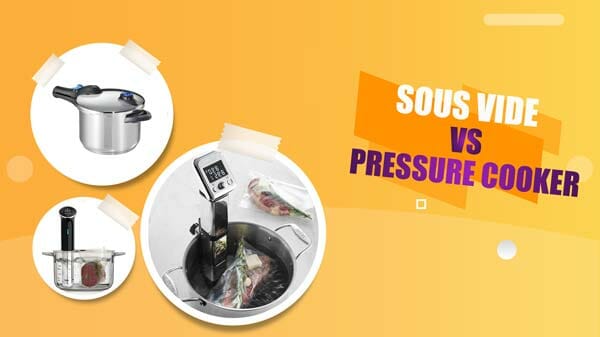You do not have to be a professional cook to love making delicious dishes at home. If you like dabbling in the kitchen, then you should already have a pressure cooker sitting on your shelf. And if you are particularly sensitive about cooking, you might even have a sous vide cooker.
For those that do not know, sous vide is a different way of cooking tasty dishes if you do not want to use a pressure cooker and have a bit of time on your hands. But is it really better than using a pressure cooker? Well, it depends.
In this article, we will compare Sous vide vs. Pressure cooker and help you decide whether you want to go with a sous vide cooker or a pressure cooker for cooking a dish. So, without further delay, let us dive in.
How Does Pressure Cooking Work?
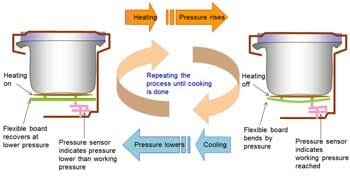
The pressure cooker is a pretty common piece of equipment in most home kitchens. This appliance allows you to cook food quickly using extremely high heat under pressure.
The best thing about this type of cooking is that you will save a lot of time without compromising the flavor of the food. The working principle of a pressure cooker is quite simple.
You put the materials you are cooking into a sealed pot along with water. When it starts to heat up, the water inside the pot turns to steam which increases the pressure inside. With the rising pressure and heat, the ingredients start to cook faster.
So essentially, the two main elements of a pressure cooker are steam and pressure. This cooking method makes the food quite tender, which is why it is a popular way to cook meat.
Advantages Of Using a Pressure Cooker
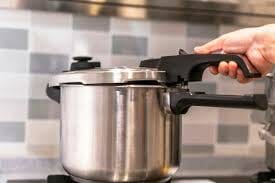
You should pick the method that best suits your needs, since these two cooking methods and devices are very different.
The pressure cooker cooks meals in only 30 minutes or less, making it the fastest of the two. Tougher cuts of meat may require more time depending on the ingredients used. A decision on which appliance to purchase should, of course, be based on this.
Using pressure cookers, you can produce foods that would normally take hours to cook in a fraction of the time.
Since I turned to the pressure cooker, I have saved lots of time. If you need a cooking method in which you can just throw everything into a pot and let it cook, then a pressure cooker is a better choice.
There's just something more convenient about the sous vide cooker than most other sous vide cooking tools. Additionally, both are very simple and need little maintenance.
Most people are familiar with the Instant Pot, which is a pressure cooker. Low-temperature cooking is also possible with this. It can thus replace other appliances like rice cookers, slow cookers, and dishwashers.
Disadvantages Of Using A Pressure Cooker
While pressure cooking can quickly dry out meat, it's crucial to keep an eye on the time. A pressure cooker cooks more quickly than an oven, slow cooker, or sous vide cooker. If overloading a pressure cooker, food will continue to heat up, resulting in overcooking.
How Does Sous Vide Work?
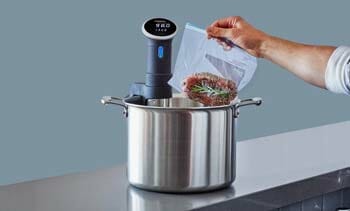
Where pressure cooker is all about using high heat to make quick food, sous vide is about maintaining a low temperature. This is a popular way of cooking in a lot of restaurants.
Sous vide cooking takes a lot of time since it is a gentle cooking process. But with this technique, you can achieve excellent flavors that you cannot get using a pressure cooker.
Sous vide cooking requires a cooker, a water bath, plastic bags, vacuum sealers, and an immersion circulator. The idea is to set the immersion circulator at a low temperature and set the timer accordingly.
Then you have to place it in the bowl of water. After that, seal your food ingredients in the plastic bags and put them in the water bowl.
Then wait while the immersion circulator cooks the food at the set time. Since sous vide cooking is a slow cooking process, it is not for people who want to make a quick dish.
However, you can leave the immersion circulator to do the cooking on its own while you take care of other businesses. The price of a sous vide cooker is slightly higher than a typical pressure cooker.
Advantages of Using a Sous Vide
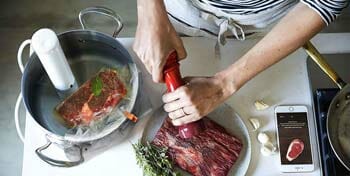
You can set the temperature and time on a sous vide immersion circulator. Adapting to temperature changes will then be accomplished via communication between the heating element and the sensors. The circulator keeps ingredients from overcooking by instantly regulating the temperature.
The best ways to make dishes taste great, in my opinion, are the choices of ingredients and spices, as well as doneness and texture.
The last thing anyone wants to eat is dry meat, isn't it? Sous vide allows you to duplicate the methods used by chefs at top-tier restaurants.
Disadvantages Of Using a Sous Vide
By comparison, sous vide is not as fast as pressure cooking. Sous vide cooking is all about cooking at low temperatures for a long period of time.
Sous Vide vs. Pressure Cooking: What's The Actual Difference?
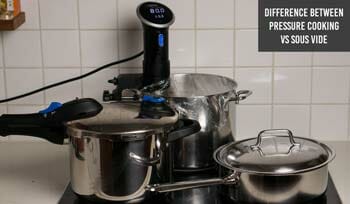
Both sous vide, and pressure cooker cooking can be used to prepare delicious home meals. You can find a lot of different recipes online quite easily.
But if you are wondering whether you will have a better cooking experience with one over the other, the following section of the article is for you.
In this section, we will look at a few ways to identify whether you want to use pressure cooking or sous vide cooking.
1. Cooking Temperature
The first thing you want to consider is the cooking temperature of the meal. Pressure cookers cook using extremely high temperatures of up to 400 degrees Fahrenheit.
On the other hand, Sous vide can go only as high as 135 degrees Fahrenheit, which is a much gentler and lower temperature for cooking.
So, if you are preparing a dish that requires a high temperature to cook properly, using a pressure cooker might be the better choice.
With sous vide, you will get better results from dishes that require consistent access to a lower temperature. Since it can maintain the temperature so well, you do not have to worry about overcooking your food.
2. Desired Texture Of The Food
Sous vide cooking, and pressure cooking your food leave different textures on your food. This is another factor you might want to consider before going with one type of cooking over the other.
Don’t worry; both cooking processes can let you create tender meats, so that is not an issue. However, with sous vide way, since the juices are not released due to lack of pressure, the meat will not be stringy.
Since pressure cooking involves putting the ingredients under a lot of pressure from the steam and high heat, the meat often comes out stringy. That is not necessarily a bad thing, though. It mostly depends on your tastes.
3. Time Required
Another thing that you want to consider when choosing your preferred cooking process for a certain dish is how much time you have on your hands. We have already said sous vide cooking is a slower, gentler cooking process.
So, if you want to prepare a dish quickly, this is not the best choice. On the other hand, pressure cooking will let you cook your meat or any other dish for 10 to 15 minutes.
For people who are in a rush and want to prepare a meal for themselves or friends quickly, pressure cooking is the way to go.
However, make sure you do not dry out the ingredients by turning up the heat too high when using a pressure cooker.
How To Sous Vide Without A Sous Vide Cooker?
Sous vide cookers can be quite expensive. Even a basic cooker will cost you a lot more than an average pressure cooker. That is why you will not see it as often in a home kitchen.
And if you would rather not invest in a new cooking appliance, then the following steps will help you sous vide without a sous vide cooker.
Things You Need
The main idea of a sou vide cooker is to maintain the water temperature consistency. If you want DIY sous vide cooking experience, you will need a few things like a large pot, a couple of Ziploc bags, some binder clips, and a cooking thermometer to monitor the temperature.
Steps For Sous Viding
Once you have everything, you are ready to get started. Here are the basic steps to sous vide cooking without a sous vide cooker.
Prepare The Water
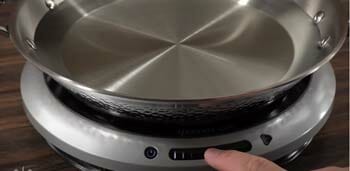
Start off by filling up the large pot with water. Since you will immerse your ingredients in the pot, you need to fill it up to the brim. However, make sure you do not overflow the water.
Place The Thermometer
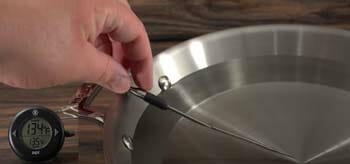
For the next step, you want to place the thermometer inside the large pot. The main purpose of the thermometer is to monitor the cooking temperature and keep it stable. We recommend going with a digital thermometer as you can monitor it from further away.
Use your binder clips to fasten the thermometer to the large pot. Make sure it does not have any wiggle room. If the thermometer moves around a lot, your readings might not be accurate.
Heat Up The Water
Once everything is in place, you want to start heating up the pot. The appropriate temperature depends on the type of dish you are cooking.
Ideally, you want to maintain the temperature around 2 degrees of what you need.
So, you need to ensure that the temperature does not go above or below two degrees of your desired temperature.
Seal The Food
Take your ingredients and seal them up using the Ziploc bag. Make sure the bags are suitable for cooking. There are some Ziploc bags in the market that emit toxic chemicals when heated. You need to buy kitchen Ziploc bags that are free of any toxic chemicals.
Before putting the ingredients inside the bags, make sure you chop them up into portion sizes. That way, the cooking will be more even. You can also seal up the pot, which will help you maintain the temperature easier.
Cook Your Meal
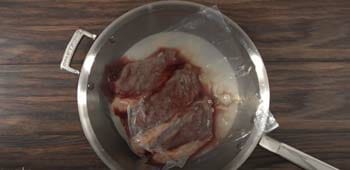
Now that you are all set, you may now start cooking. You should already know how long you need to cook from the dish recipe.
Check regularly to see if the proper temperature is maintained. With sous vide cooker, you can walk away, and the cooker will regulate the temperature.
Since you are going with a DIY solution, you need to check in periodically. Once the required time has passed, your food should be cooked and prepared to serve.
Which One Is For Me?
The results (read: tender stuff) can be similar, but the flavors are different because of the temperature the food reached. In a pressure cooker, you will never be able to get short ribs that are medium rare.
As for short ribs, sous vide takes longer. You can split the difference with a slow cooker. The cooking temperature is higher than sous vide, so it's not as fast as a pressure cooker.
Final Thoughts
Sous vide and Pressure cooking are two completely different ways of cooking food. And the taste of the food with one process is quite different than the taste of the other method.
Which one you go with ultimately comes down to your preference. We hope our elaborate comparison between sous vide vs. pressure cooker could help you figure out which process is better for your next meal.
Up Next: Top 6 GE MWF refrigerator water filter smartwater compatible cartridge.
SeaRanchLodge.com is a participant in the Amazon Associate program and will earn from qualifying purchases.


